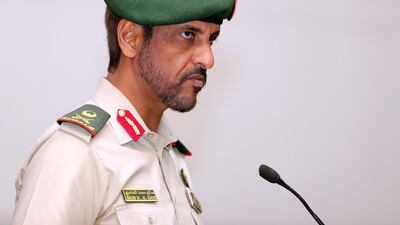Thousands of improvised explosive devices were defused by the UAE Armed Forces last year, saving countless lives, a forum heard on Tuesday in Abu Dhabi.
Explosive ordnance disposal teams “successfully neutralised in the coastal front alone 2,610 IEDs,” said Maj Gen Saleh Mohammed Al Ameri, commander of land forces. He was speaking to an audience of roughly 200 officers and guests gathered for the first C-IED Lessons Learned Conference held at the Armed Forces Officers Club.
The bombs were found across six unidentified countries last year and safely disposed of.
The threat of improvised explosive devices continues to be a “top priority” for the UAE military, said Maj Gen Al Ameri.
In Yemen last year, 146 people were killed from blasts caused by improvised bombs, according to the UAE Armed Forces, including 30 children. 164 were injured, including 28 children and 26 women.
“The Iranian Houthi militias began extensively using various types of IEDs, especially when the Arab Coalition Forces launched the operation to liberate the Red Sea coastal cities last year,” he said.
“These guerrillas have never used such new types of IEDs before. These militias would not be able to develop methods of killing and destruction unless supported by a regional network of terrorist-sponsoring states and organizations that provide them with money, equipment and expertise.”
Samples of the IEDs collected were displayed on the sidelines of the two-day conference, which continues on Wednesday.
One IED on display looked like a sophisticated rocket, while another appeared in the shape of a large boulder that could be camouflaged to look like any typical rock, but was hollowed out to contain the bomb. Another was simply a tangle of wires, while a fourth was a regular water can rigged with explosives.
“Improved explosive devices constitute a terrorist’s most lethal threat for killing and destruction, thus demoralising civilians and pushing them to lose confidence in their government’s ability to protect them,” said Maj Gen Al Ameri.
“This threat also affects the military units by limiting their ability to move and maneuver. In spite of being tactical weapons, improvised explosive devices have great impact at the strategic level.”
The conference featured representatives from the US, UN, France, Pakistan, UAE, Saudi Arabia and the UK who will demonstrate the lessons they learned through their experiences of defeating IEDs in Afghanistan, Iraq, Syria, Africa, Pakistan and Yemen.
“The IED threat is ever-changing and evolving,” the major said.
“Unlike 10 years ago, terrorists are no longer restricted to land means ... they have widened the threat to include airborne IEDs and waterborne IEDs.”
Officials from the United Nations Mine Action Service also spoke of the impact of IEDs in Somalia. Since last year, there have been 484 detonations, including a truck bomb at a busy intersection that killed 645 people.
“It has now become the weapon of choice for local insurgents,” said Quentim Ygorra, a C-IED operations analyst with the UNMAS.

